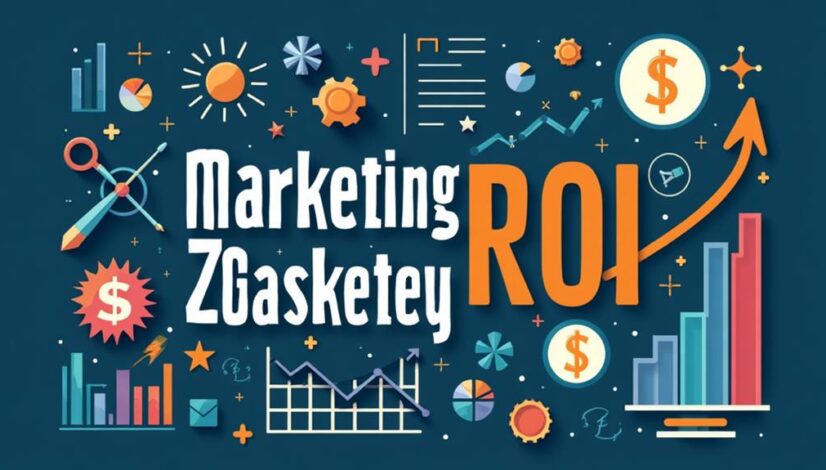How to Build a Marketing Strategy That Maximizes ROI
To build a marketing strategy that maximizes ROI, begin by defining clear business goals that align with your organizational objectives. Understand your target audience through detailed segmentation and psychographic analysis. Conduct thorough market research to identify trends and analyze competitor strategies. Establish a flexible budget prioritizing high-impact initiatives. Create compelling, diverse content that resonates with your audience. Implement robust tracking tools to measure performance and facilitate data-driven decisions. Regularly optimize and adjust strategies based on key performance metrics. This approach guarantees that your marketing efforts remain effective and aligned with market dynamics, revealing further opportunities for improvement.
Key Takeaways
- Define clear business goals to align marketing initiatives with organizational objectives and facilitate accountability.
- Understand your target audience through segmentation and detailed customer personas to deliver resonant messaging.
- Conduct thorough market research to identify gaps, trends, and competitor strategies that inform positioning and enhance uniqueness.
- Evaluate marketing tactics by analyzing performance metrics, ensuring continuous improvement and effective resource allocation.
- Choose appropriate channels and create compelling content that engages your audience and maximizes return on investment.
Define Your Business Goals

Defining your business goals is the cornerstone of an effective marketing strategy, as it provides a clear direction and purpose for all promotional efforts. Establishing specific business objectives enables organizations to create a robust framework that balances ambition with measurable outcomes.
Strategic alignment guarantees that each marketing initiative resonates with broader organizational aims, thereby fostering consistency across all channels. Engaging stakeholders in this process is vital. Collaborative dialogue encourages diverse perspectives, ultimately enriching the goal-setting exercise.
By recognizing stakeholder interests early, businesses can proactively assess risks associated with various strategies, guaranteeing sustainable growth. Clear performance indicators allow for meaningful tracking of progress against these defined objectives, fostering accountability and commitment.
Resource allocation becomes more strategic when underscored by well-defined goals. This assessment empowers organizations to discern which projects warrant investment and attention, optimizing both financial and human resources.
Meanwhile, time is of the essence; timeline planning is imperative in this dynamic environment to maintain momentum and responsiveness. Risk assessment further enhances the planning process by identifying potential pitfalls that could threaten the attainment of success metrics.
These metrics not only gauge the effectiveness of individual initiatives but also offer insights into overall organizational health.
Understand Your Target Audience
With well-defined business goals in place, the next significant step involves a thorough understanding of your target audience. Effective audience segmentation is essential for maximizing ROI; it allows businesses to classify potential customers into specific categories. This classification can be achieved through demographic profiling, where age, gender, and income inform initial strategies.
However, to access deeper insights, psychographic analysis is equally important. It explores motivations, values, and lifestyles that drive consumer behavior.
Crafting detailed customer personas brings all these elements together. These personas serve as archetypes to guide your engagement strategies, ensuring your messaging resonates with the needs and desires of your audience. Incorporating behavior analysis into your strategy allows for a nuanced understanding of content consumption patterns and buying triggers, revealing what compels your audience to act.
In this evolving marketing landscape, creating effective feedback loops is paramount. Engaging your audience invites valuable insights into their communication preferences and helps refine your approach continually. By understanding how customers prefer to engage with your brand, you can tailor your content to resonate on a personal level, thereby fostering loyalty and trust.
Ultimately, comprehending your target audience is not a one-time endeavor. It's a dynamic process that requires ongoing analysis and adaptation to remain relevant. Embracing these methods helps you create an agile marketing strategy that not only captures attention but also converts interest into action—accessing the freedom and potential for sustained growth.
Conduct Market Research

Conducting thorough market research is essential for crafting a successful marketing strategy, as it enables the precise definition of the target audience.
By analyzing competitor strategies, businesses can identify gaps in the market and refine their unique selling propositions.
Additionally, recognizing emerging market trends allows companies to adapt proactively, ensuring sustained relevance and competitiveness in a dynamic landscape.
Define Target Audience
Identifying a target audience is essential for crafting an effective marketing strategy, as it provides the foundation for all subsequent efforts. Market research enables companies to implement audience segmentation, breaking down potential customers into distinct groups based on various criteria.
Employing demographic analysis illuminates key characteristics such as age, gender, and income, while psychographic profiling explores personality traits, values, and lifestyle choices.
Further refining this approach, behavior tracking reveals patterns in customer interactions, facilitating the development of detailed customer personas. These personas act as strategic archetypes, allowing businesses to tailor engagement strategies that resonate with each segment.
To maintain a dynamic understanding of the audience, continuous feedback collection becomes imperative, ensuring that the strategies evolve with changing preferences and needs.
Niche identification also plays an essential role, as it pinpoints specific market segments underserved by competitors. By employing targeted techniques grounded in the findings of thorough research, businesses can develop tailored communication preferences that foster deeper connections.
This strategic blend of insightful data and creative execution opens the potential for maximizing ROI and cultivating lasting customer loyalty in a landscape that values freedom and choice.
Analyze Competitor Strategies
Analyzing competitor strategies is integral to developing a robust marketing strategy, as it allows businesses to gain insights into market dynamics and identify best practices within the industry. By evaluating competitor strengths and weaknesses, companies can uncover gaps in the marketplace, positioning their unique selling propositions effectively.
A thorough examination of competitors' market positioning reveals how they shape brand perception among consumers. It's essential to analyze their pricing strategies; are they positioned as premium offerings or budget-friendly options? This understanding directly influences how your business can tailor its own pricing for competitive advantage.
Moreover, investigating customer engagement practices can illuminate effective communication tactics that resonate with target audiences. Reviewing digital presence and advertising tactics provides insights into the tools competitors use to capture market share, from social media campaigns to influencer partnerships.
Additionally, understanding their promotional offers can help craft compelling campaigns that differentiate your brand. By synthesizing these insights, businesses can craft strategies that not only compete but thrive, leading to a significant increase in ROI and a stronger foothold in the market.
The freedom to innovate and refine approaches stems from this exhaustive analysis.
Identify Market Trends
Understanding market trends is essential for businesses aiming to remain competitive and relevant. Conducting meticulous market research allows organizations to uncover valuable insights into emerging technologies and consumer behavior, shaping their strategic decisions.
By analyzing economic indicators and demographic shifts, companies can develop a keen understanding of prevalent market conditions.
Social media trends are often reflective of cultural influences, providing a real-time barometer of consumer sentiment and engagement. This awareness enables businesses to tailor their messaging and product offerings accordingly.
Additionally, considering environmental factors and industry innovations positions a brand as forward-thinking and adaptable.
It's imperative to remain vigilant regarding seasonal fluctuations and regulatory changes that may impact operations and consumer preferences. A thorough approach not only identifies current trends but also anticipates future shifts, enabling proactive responses to market dynamics.
In this freedom-driven landscape, the ability to pivot based on identified trends empowers businesses to innovate, connect with their audience, and maximize return on investment.
Consequently, an ongoing commitment to identifying and understanding market trends is not just beneficial; it's essential for sustained success in an ever-evolving marketplace.
Analyze Competitor Strategies
Analyzing competitor strategies is essential for understanding market positioning and identifying potential gaps in your own approach.
By identifying key competitors, evaluating their marketing tactics, and benchmarking performance metrics, businesses can uncover insights that drive strategic adjustments.
This thorough analysis not only enhances competitive intelligence but also informs the development of more effective marketing strategies.
Identify Key Competitors
How do successful companies stay ahead in an increasingly competitive landscape? The answer lies in a meticulous competitive landscape analysis. Identifying key competitors provides essential insights into market positioning strategies and unique selling propositions that distinguish industry leaders.
Companies should conduct a thorough competitor strengths assessment, focusing on areas where rivals excel and identifying potential gaps in their own offerings. This approach enables businesses to implement effective brand differentiation tactics, allowing them to carve out a unique niche in the marketplace.
Market share evaluation emerges as a crucial component, revealing how competitors perform relative to one's own brand. Pricing strategy comparison is equally critical; understanding how pricing aligns with perceived value can guide strategic decisions.
Furthermore, customer feedback analysis reveals how competitors are perceived, offering valuable lessons for improvement. Promotional activity assessment enhances understanding of marketing effectiveness across competitors, revealing successful campaigns and tactics.
Evaluate Marketing Tactics
A competitor's strategic choices can serve as a powerful benchmark for evaluating one's own marketing tactics. By conducting a thorough analysis of competitor strategies, businesses can refine their approach to customer segmentation and optimize tactic effectiveness. This involves a systematic performance evaluation, identifying which marketing channels produce the best ROI measurement.
Campaign analysis is essential; examine how competitors engage their audience and what methods yield superior audience engagement. By leveraging these insights, companies can implement more effective marketing strategies that capture market share. Tactic comparison offers valuable visibility into shifts in customer preferences, revealing what has successfully resonated with target segments.
Resource allocation is another critical aspect; organizations must determine if competitors are investing in innovative tools or platforms that maximize outreach and conversion rates. Establishing feedback loops based on competitor performance can inform continuous improvement.
Benchmark Performance Metrics
Benchmarking performance metrics against competitors provides a framework for evaluating the effectiveness of marketing strategies. By implementing robust benchmarking techniques, businesses can conduct rigorous performance analysis that reveals insights into their market positioning. This process involves meticulous metric selection to guarantee alignment with industry standards and relevant objectives.
Data interpretation is vital in this scenario, as it allows companies to draw meaningful conclusions from their performance comparison with competitors. Engaging in this analysis fosters a deeper understanding of competitive advantages and shortcomings while highlighting areas for growth. The application of performance visualization tools can further enhance this interpretation, making complex data more accessible and actionable.
Continuous metric tracking is essential for a dynamic ROI assessment. By regularly reviewing key performance indicators, businesses can quickly pivot their strategies based on real-time feedback. This approach not only promotes goal alignment across marketing initiatives but also encourages the freedom to innovate and experiment within structured boundaries.
Ultimately, benchmarking against competitors can empower organizations to refine their marketing strategies, guaranteeing they maximize ROI while staying adaptable in a rapidly changing digital landscape.
Set a Budget

Establishing a well-defined budget is crucial for the successful execution of any marketing strategy. It serves as a roadmap for budget allocation, enabling businesses to prioritize investments while maintaining oversight through cost control.
As marketers navigate the complex financial landscape, effective financial forecasting becomes essential for identifying ideal spending limits and ensuring resource management aligns with strategic goals.
Consider the following critical components when setting your budget:
- Investment Priorities: Determine which marketing initiatives yield the highest potential ROI. Focus resources on channels that align with your overall strategy and show promise for returns.
- Expense Tracking: Employ robust expense tracking systems to monitor expenditures in real-time. This practice allows for timely adjustments and enhances budget flexibility, ensuring you can pivot as market conditions change.
- ROI Analysis: Regularly conduct ROI analysis to evaluate the effectiveness of your spending. This reflective process informs future financial planning, allowing for data-driven adjustments that enhance the overall marketing strategy.
Budgeting is not merely an exercise in restraint but a blueprint for freedom—a means to harness resources effectively while paving the way for innovative marketing initiatives.
Choose the Right Channels
How can businesses effectively reach their target audience amidst an ever-evolving digital landscape? The key lies in choosing the right channels for marketing efforts. Understanding audience segmentation is essential; businesses must identify the specific demographics and preferences of their target market to tailor their approach.
With the plethora of digital platforms available—ranging from social media to email marketing—selecting the most appropriate channels can greatly enhance content distribution efficacy.
Evaluating channel effectiveness should be a data-driven exercise, focusing on metrics such as conversion rates. For instance, social media platforms are increasingly important for real-time engagement, while email marketing remains a powerful tool for direct communication and sustained connections.
Traditional media, despite its declining reach, still holds sway in specific contexts, particularly for older demographics or local campaigns.
Integrating influencer partnerships can also yield remarkable outcomes, expanding audience reach and adding an element of personal endorsement that resonates with potential customers. However, it is essential to align influencer choices with brand values to maintain authenticity.
Ultimately, the allocation of advertising budgets must reflect a strategic selection of channels, ensuring that funds are invested where they yield the greatest returns.
A multifaceted approach that balances digital and traditional channels, while continuously analyzing performance metrics, will empower businesses to optimize their strategies for maximum ROI.
In this complex digital ecosystem, the freedom to experiment and adapt in channel selection is fundamental for sustained success.
Create Compelling Content

Compelling content is the cornerstone of any successful marketing strategy, serving as the bridge between a brand and its audience. By effectively leveraging various content types and emotional storytelling techniques, businesses can create memorable experiences that resonate deeply with their audience, fostering brand loyalty and driving engagement.
Here are three strategic approaches to creating such compelling content:
- Incorporate Visual Elements: Infographics, videos, and engaging imagery can enhance the storytelling aspect of your content, ensuring it captures attention effectively. Visuals not only improve understanding but also increase shareability, boosting audience distribution.
- Utilize User Generated Content: Encourage your audience to contribute their own stories and experiences with your brand. This approach not only enhances authenticity but also fosters a community around your brand, deepening audience engagement.
- Develop a Robust Content Calendar: Structure your content distribution by planning ahead. Establishing a content calendar allows for consistent posts aligned with your objectives, ensuring that each piece maintains your brand voice and adheres to SEO optimization practices.
In the digital landscape, where attention spans are fleeting, prioritizing these elements can dramatically improve the effectiveness of your marketing strategy.
Through strategic blog promotion and a diverse range of content types, brands can effectively communicate their messages while simultaneously empowering their audience to participate in the narrative.
Implement Tracking Tools
In the digital marketing landscape, the selection of appropriate tracking tools is essential to measure the effectiveness of your strategies.
By monitoring key metrics, organizations can gain actionable insights that inform future marketing decisions.
Regular data analysis not only aids in optimizing current campaigns but also enhances long-term strategic planning.
Select Appropriate Tools
Selecting the right tools for tracking and measurement is essential for executing an effective marketing strategy. The landscape of marketing software is vast, and choosing the appropriate tools can enhance your ability to maximize return on investment.
By harnessing the right resources, you can streamline processes, analyze customer behavior, and optimize campaigns tailored to your audience.
Here are three critical types of tools to evaluate:
- Analytics Platforms: Utilize robust analytics platforms to interpret data from various campaigns, offering insights that drive decision-making.
- Automation Tools: Implement automation tools for email marketing and social media management, allowing you to reach your audience consistently without sacrificing personalization.
- SEO Tools: Invest in SEO tools to enhance your visibility and content management capabilities, ensuring your brand stands out in an increasingly competitive market.
Incorporating these tools will empower you to track your marketing efforts effectively, while fostering strong customer relationships.
A strategic approach enables you to engage your audience meaningfully, ensuring that each marketing initiative contributes to your overall goals and freedom to explore new avenues in your campaigns.
Monitor Key Metrics
Monitoring key metrics is essential for evaluating the effectiveness of your marketing strategy and ensuring alignment with your business objectives. By leveraging a metrics dashboard, you can consolidate various performance indicators into a single, cohesive view. This data visualization not only simplifies the interpretation of complex datasets but also empowers decision-making.
Utilizing robust tracking software enhances your ability to conduct thorough ROI analysis. Such tools enable you to assess the financial impact of your marketing initiatives in real time. By focusing on marketing analytics, you can identify trends, uncover insights, and optimize campaigns with precision.
Moreover, effective KPI development is critical for measuring your success. Choose performance indicators that resonate with your strategic goals, ensuring that they reflect the true essence of your business's aspirations.
Implement extensive reporting tools that allow for seamless data aggregation and facilitate clear communication across your organization. In this way, monitoring key metrics fosters a culture of accountability and agile adaptation.
Embrace these insights as a means to drive freedom in your decision-making and empower your marketing strategy to achieve extraordinary results.
Analyze Data Regularly
Regular data analysis is essential for optimizing your marketing initiatives and driving continuous improvement. By leveraging powerful reporting tools and engaging in thorough trend analysis, you can reveal valuable audience insights to enhance your strategy.
To maximize your marketing efforts, consider focusing on:
- Customer Behavior: Understanding how customers interact with your brand helps in tailoring your approach for better engagement.
- Predictive Analytics: Utilize techniques for performance forecasting to anticipate outcomes and adjust strategies proactively.
- Data Segmentation: Grouping data effectively allows for a nuanced exploration of your audience, fostering targeted conversion optimization.
Incorporating data visualization techniques will empower you to discern patterns and gauge engagement metrics, providing a clearer picture of your marketing landscape.
This approach fosters an environment of continuous adaptation and refinement.
Regularly analyzing data not only fuels strategic decisions but also unveils the potential of your campaigns. By understanding shifting trends and behaviors, you can assert your freedom to innovate and respond promptly, ensuring sustained ROI and significant business impact.
Embrace this analytical mindset, and watch your marketing strategy flourish.
Measure Performance Regularly

To guarantee the effectiveness of any marketing strategy, it is essential to establish a routine for measuring performance, as this provides actionable insights that can drive continuous improvement. Regularly evaluating performance indicators such as conversion rates, customer engagement, and ROI forms the backbone of informed decision-making.
But beyond mere data collection, this process requires the establishment of feedback loops that foster ongoing dialogue among team members and stakeholders. Stakeholder involvement is essential to guarantee that everyone is aligned with the strategic goals of the marketing campaign.
By incorporating diverse perspectives, organizations can enhance resource allocation, ensuring that budgets and efforts are directed toward the most impactful initiatives. The alignment between marketing activities and overarching business objectives enhances coherence and maximizes returns.
Furthermore, team collaboration plays a significant role in effective performance measurement. When teams collectively engage in goal setting, they foster a culture of accountability and innovation.
Utilizing data visualization techniques can transform complex datasets into digestible insights, making it easier for teams to evaluate their progress and adapt their strategies as necessary. A systematic approach to risk evaluation is also fundamental, allowing marketers to proactively identify potential pitfalls and adapt their strategies in real-time.
Optimize and Adjust Strategies
A well-crafted marketing strategy is a living document that thrives on constant optimization and adjustment. To maximize your ROI, embracing an agile marketing approach is essential. By continuously evaluating performance and integrating customer feedback, you can align your resources more effectively to respond to market shifts and enhance your strategies.
Consider implementing these three vital tactics for optimization:
- Regular Strategy Evaluations: Schedule frequent assessments of your marketing initiatives. This process guarantees that you can identify underperforming campaigns and make necessary campaign adjustments, which can greatly improve overall performance.
- Leverage Feedback Loops: Establish mechanisms for gathering customer feedback and insights. Utilize this data to adapt your approaches and enhance customer satisfaction, thereby fostering loyalty and increasing your ROI analysis over time.
- Maintain Budget Flexibility: A dynamic approach to resource allocation allows for quick responses to market changes. Adjust your budget based on performance metrics to guarantee that funds are directed towards the most effective channels, optimizing overall strategy execution.
Incorporating these tactics guarantees that your marketing strategy remains relevant and responsive, thereby enhancing performance optimization.
Frequently Asked Questions
What Are Common Mistakes to Avoid in Marketing Strategies?
In crafting effective marketing strategies, common mistakes can severely hinder outcomes.
Failing to accurately define the target audience results in misaligned messaging and wasted resources.
Poor budget allocation often leads to inadequate support for high-performing channels.
Neglecting performance metrics prevents necessary adjustments, while inconsistent content alignment can confuse potential customers.
Additionally, improper channel selection detracts from brand consistency, ultimately diminishing overall impact.
Strategic awareness of these pitfalls is essential for achieving success.
How Often Should I Update My Marketing Strategy?
Like a garden, a marketing strategy thrives with regular attention and care.
Ideally, strategy assessment should occur quarterly, aligning marketing frequency with evolving market dynamics, consumer behavior, and competitive landscapes. This cadence allows for agile adjustments and guarantees continued relevance.
However, significant market shifts may necessitate more immediate revisions. Consequently, fostering a culture of continuous evaluation empowers organizations to adeptly seize untapped opportunities and develop campaigns that resonate with target audiences.
Can I Use Previous Campaigns for Future Strategy Insights?
Yes, utilizing insights from previous campaigns can greatly enhance future strategy development.
Conducting thorough data analysis allows for a robust understanding of past campaign performance, revealing what resonated with target audiences.
Additionally, trend identification from historical results can aid in predicting future behaviors and preferences.
What Tools Can Help With Competitor Analysis?
Ah, the pursuit of competitor analysis—how wonderfully ironic that in seeking freedom from competition, we must first understand it!
To navigate this complex landscape, tools such as SEMrush and SimilarWeb provide invaluable competitive benchmarking and market intelligence.
These resources empower businesses to identify strengths and weaknesses within the competitive framework, fostering strategic creativity.
Ultimately, leveraging such insights can pave the way for innovative approaches that distinguish you in a crowded marketplace.
How Do I Handle Negative Feedback in Marketing?
Handling negative feedback in marketing requires a strategic approach focused on customer sentiment and reputation management.
Implementing feedback loops can facilitate constructive criticism, enabling brands to address concerns proactively.
Employing response strategies, such as personalized responses and acknowledging issues, can demonstrate commitment to customer satisfaction.
Additionally, leveraging social listening tools allows brands to monitor sentiments and adapt accordingly, fostering trust and enhancing overall brand perception amidst challenges.
Conclusion
A marketing strategy is akin to steering a ship through treacherous waters; without a clear destination and understanding of the currents, one risks being adrift. Maximizing return on investment requires a harmonious blend of rigorous analysis, targeted outreach, and adaptive practices. As organizations commence on this journey, they must remain vigilant in measuring performance and recalibrating their approach, ensuring that every marketing initiative steers closer to the intended goals while avoiding potential pitfalls.




